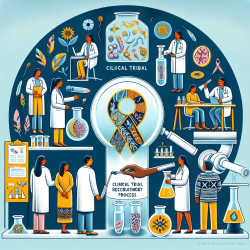Introduction
As speech-language pathologists (SLPs), our mission is to provide the best possible outcomes for children with diverse needs. One such group includes children with Dandy-Walker Malformation (DWM) and Wisconsin Syndrome (WS). Recent research, such as the study titled Dandy-Walker malformation and Wisconsin syndrome: novel cases add further insight into the genotype-phenotype correlations of 3q23q25 deletions, offers valuable insights that can enhance our practice. This blog aims to translate these findings into actionable steps for SLPs, helping us make data-driven decisions to improve therapy outcomes.
Understanding the Research
The study by Ferraris et al. (2013) focuses on the genetic underpinnings of DWM and WS, particularly deletions in the 3q23q25 chromosomal region. The research identified three novel patients with heterozygous 3q deletions encompassing the ZIC1 and ZIC4 genes. The findings indicate that these deletions are associated with a range of congenital anomalies, including DWM and WS, but with incomplete penetrance. This means that not all individuals with these deletions will exhibit the full spectrum of associated anomalies.
Key Takeaways for Practitioners
Here are some practical ways to integrate these research findings into your practice:
- Early Identification: Be vigilant in identifying signs of DWM and WS early. This includes recognizing facial dysmorphisms and developmental delays that may warrant further genetic testing.
- Collaborative Approach: Work closely with geneticists and neurologists to understand the specific genetic profiles of your clients. This collaborative approach ensures a comprehensive understanding of each child's unique needs.
- Customized Therapy Plans: Use the detailed clinical phenotypes provided in the study to tailor your therapy plans. For example, children with severe intellectual disabilities may benefit from more intensive language and communication interventions.
- Family Education: Educate families about the genetic aspects of DWM and WS. This knowledge empowers them to make informed decisions and advocate for their child's needs.
Encouraging Further Research
While the study provides significant insights, it also highlights the complexity of the genetic basis of DWM and WS. As practitioners, we should advocate for and participate in further research to deepen our understanding. Here are some ways to get involved:
- Join Research Networks: Participate in research networks and studies focusing on congenital anomalies and genetic disorders. Your clinical insights can contribute to a broader understanding of these conditions.
- Data Collection: Systematically collect and share data from your practice. This data can help identify patterns and inform future research directions.
- Continuing Education: Stay updated with the latest research by attending conferences, webinars, and workshops. This continuous learning ensures that your practice is informed by the most current evidence.
Conclusion
The study by Ferraris et al. (2013) offers valuable insights into the genotype-phenotype correlations of 3q23q25 deletions, enhancing our understanding of DWM and WS. By integrating these findings into our practice, we can make more informed, data-driven decisions that improve outcomes for children with these conditions. As we continue to learn and grow, let us remain committed to research and collaboration, ensuring that we provide the best possible care for our young clients.
To read the original research paper, please follow this link: Dandy-Walker malformation and Wisconsin syndrome: novel cases add further insight into the genotype-phenotype correlations of 3q23q25 deletions.










